Maine Vacation - 2018
My Maine vacation this year was not what I had expected. Most of the time, the wind blew like crazy. Most of the time when it wasn't blowing it was raining. It turned out to be a spin fishing vacation rather than a tenkara vacation.
This will be a fairly quick and dirty trip report, partially because the trip didn't turn out to be a tenkara trip but mostly because I'm still behind on my shipments, and I think that should take precedent.
I did get in a little tenkara fishing and the Keeper Kebari again proved to be an outstanding smallmouth bass fly.
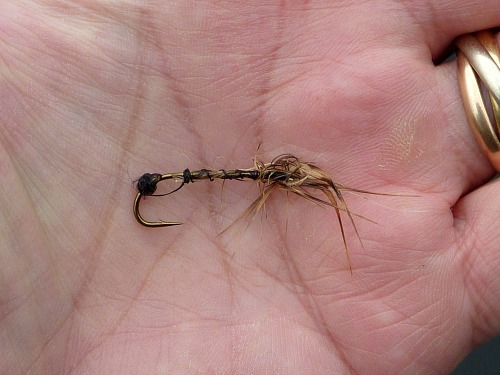 Almost time to change flies.
Almost time to change flies.If anyone ever wonders when to change a fly, the easy answer is "when it stops working." And when does it stop working? When there's nothing left.
The above Keeper Kebari (used to be) is one of my early ones, tied before I realized the fly needed a copper wire rib. Bass do not have large teeth, but after lots of fish, a yarn-bodied fly will be reduced to little more than hackle. That fly still caught fish, though. The photo was taken after the "many many-eth" fish (and just before the next one).
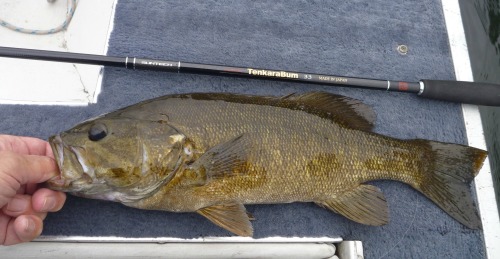 TenkaraBum 33 smallie
TenkaraBum 33 smallieOne good thing about a week's vacation is you have time to try new things. As most of you know, I am a big proponent of the "Long Rod, Short Line" approach to tenkara fishing. I am convinced that it produces better drifts and better drifts produce more strikes. On a lake, though, "better drifts" is a meaningless concept.
I practiced fishing with a line much longer than the rod, and found it to work pretty well. I still will not use it in situations where I need to keep the line off the water and am not skating or pulsing the fly while fishing downstream, but I do agree with its supporters that fishing a long line (and the resulting hand-lining) is worth practicing.
With the long line, I was able to fish a rod considerably shorter than I would normally use on a lake, and found the TenkaraBum 33 to be a pretty good bass rod. The firmer midsection (relative to the TenkaraBum 36 and 40) gives a bit better control over the fish.
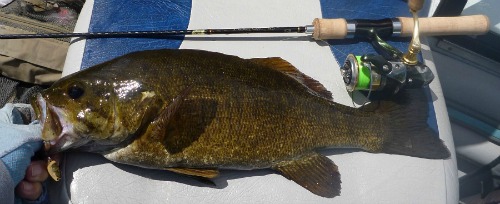 The Shimano Trout One NS S53UL handles bass just fine.
The Shimano Trout One NS S53UL handles bass just fine.Because of the almost incessant wind, I fished mostly with a spinning rod, and got a chance to fish quite a bit with the Shimano Trout One NS S53UL. It is not as fancy as the Tenryu rods, but I like it quite a bit better than the Daiwa spinning rods. It is a slightly faster rod than the Daiwas, with a softer, more responsive tip but still plenty of muscle to handle good sized fish. Unfortunately, it only comes in a two-piece rod, which is less convenient if you are backpacking or if you carry more than one rod when stream fishing. In a boat, though, that is no disadvantage.
I have a friend who is considering starting a guiding business aimed at spin fishermen rather than fly fishermen. I think the Shimano Trout One NS S53UL would be an excellent choice for his business. Clients will recognize that it is a nicer, higher quality rod and better suited to stream fishing for trout than the rod they have now (assuming they don't have a Tenryu, of course, but the Shimano is much more affordable for a beginning guide business than the Tenryu). It also fits in the Long Rod Case, so a bunch of rods in the back of a truck will still be protected.
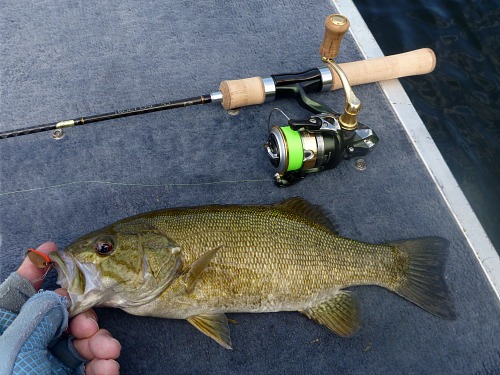 The Daiwa Lupin Spoons were very effective.
The Daiwa Lupin Spoons were very effective.Before this trip I hadn't spent much time fishing with the Daiwa Lupin spoons. They're not much bigger than the Vega spoons, but at 1.2 or 1.8 grams, they are much too heavy for a tenkara rod. For an ultralight spinning rod, though, they work extremely well. They cast well but they are small enough that they'll draw strikes from smaller fish, which often won't hit a large lure, and also for heavily pressured fish, which also often won't hit a large lure. I haven't yet caught any 6 inch brookies with them, but that's only a matter of time.
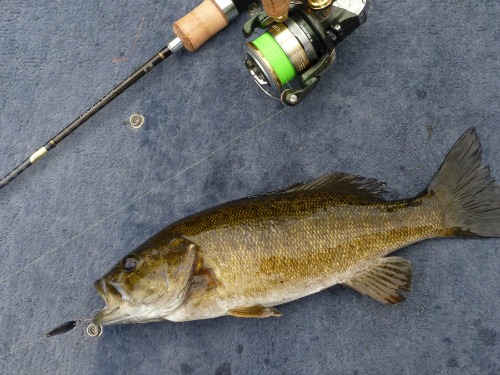 The .8g Vega spoons worked also.
The .8g Vega spoons worked also.Although I have mostly fished with gold, silver or red and gold spoons - other than the Nightmare, of course (black with orange spots), I found that darker spoons tended to work better than the bright shiny ones on this trip.
I also found (after several days of fishing) that my retrieves were generally too fast. The fish very definitely preferred a slow to very slow retrieve. I heard this past week from a spoon fishing friend in Colorado that the trout in high mountain lakes also preferred a very slow retrieve. When retrieved slowly, spoons just barely wobble back and forth, and do not spin at all. Thus, you do get fish but you don't get line twist!
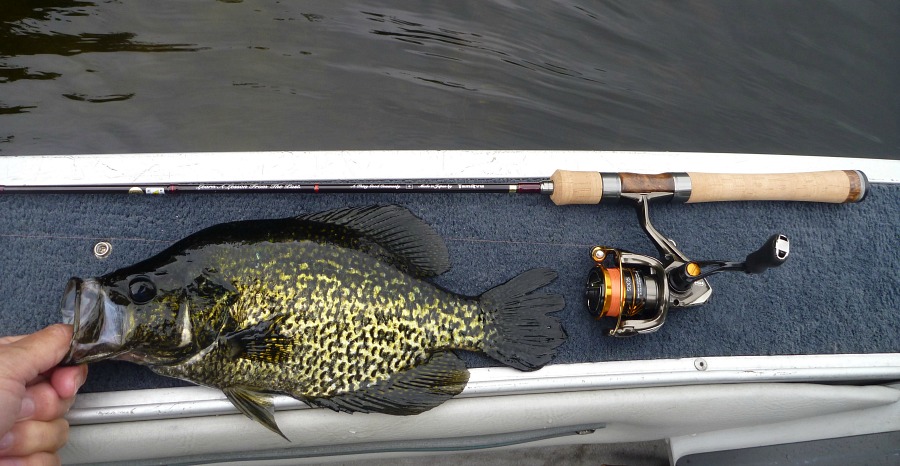 Tenryu Rayz Alter RZA61L-T makes a nice crappie rod!
Tenryu Rayz Alter RZA61L-T makes a nice crappie rod!I also got a bit more time to fish the Tenryu Rayz Alter RZA61L-T. The rod is designed for fishing in lakes, where you don't have to fight the current as well as the fish. Although designed with trout in mind, I found that it makes a wonderful crappie rod! It is able to cast very small lures and protect very light lines, and is not so stiff that it would rip hooks out of a papermouth's mouth. I did catch some bass with it as well, but I think it is better suited to crappies (and trout, of course!).
TenkaraBum Home > Trip Reports > Maine Vacation 2018
“The bitterness of poor quality remains long after the sweetness of low price is forgotten” - Benjamin Franklin
"Be sure in casting, that your fly fall first into the water, for if the line fall first, it scares or frightens the fish..." -
Col. Robert Venables 1662
As age slows my pace, I will become more like the heron.
We've all had situations where seriously chewed up flies kept catching fish after fish after fish. It is no sin to tie flies that come off the vise looking seriously chewed up.
Warning:
The hooks are sharp.
The coffee's hot.
The fish are slippery when wet.
Beware of the Dogma
What's in stock?
Suntech Tenkarakyo 40F Tenkara Rods
Coming Soon
December
Kurenai II AR 30F
Kurenai II AR 33F
Kurenai II AR 39F
Nissin Oni Line size 3
Nissin Oni Line size 3.5
TenkaraBum 33
TenkaraBum 36
TenkaraBum 40
Medium Rod Case
January
Furaibo TF39
Furaibo TF39TA
Latest Pages
If you enjoy spin fishing or baitcasting please visit my sister site Finesse-Fishing.com.


